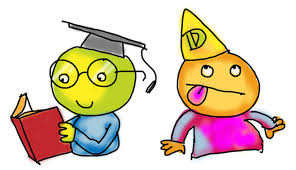
The usual way for people to think about intelligence is as a single spectrum, where we start dumb and – if we’re lucky – grow to become smart. This seems to fit neatly into the dominant thought paradigm, which is that of materialist, empiricist science. This paradigm contends that single-celled organisms evolved to become intelligent and the more intelligent the better.
This is certainly one way of looking at things and it’s a valid perspective. It’s just a little simplistic. Intelligence is so multivariate and nebulous a concept that trying to reduce it to a single number is like trying to rank all of the world’s great works of art along a single scale. It might make some kind of sense, but it’s not really meaningful.
A better way to think about intelligence is that there’s a smart spectrum and there’s a dumb spectrum. The two have some overlap, but it’s minor. These two spectrums have been generally considered to overlap entirely, in that the more dumb a person is the less smart they must be and vice versa, but anyone who has met a decent range of other people in their life will know that this isn’t true.
The most obvious counterpoint to the single spectrum of intelligence argument is the large number of hopeless nerds and autists out there. There is an archetypal absent-minded professor who knows everything about their area of expertise and nothing about any other aspect of life – someone who could lecture a class of a hundred postgraduates but can’t change a lightbulb. Always these people dominate IQ tests, but it’s not as simple as declaring them intelligent.
These people, usually men, exhibit a high reading on the smart spectrum as well as a high reading on the dumb spectrum. So they aren’t intelligent in the same way as people who are high on the smart spectrum and low on the dumb spectrum.
This is not a dig at the university sort. A majority of smart people have made themselves less dumb for the reason that they have realised how much suffering their own dumbness causes and have acted to mitigate it. After all, what other use is being smart in the first place?
Another type of person who exhibits a high reading on both the smart and dumb spectrums is someone who wastes the intelligence they were born with. Being high on the smart spectrum isn’t by itself enough to succeed in life – there are all kinds of personal qualities like perseverance, diligence and honesty to consider.
People who are high on the smart spectrum and low on the dumb spectrum are rare, and are also difficult to recognise. After all, the average person is fairly dumb, and are therefore prone to assume that truly intelligent people are themselves dumb if they disagree with that average person on anything.
In many ways, these people are compelled to hide away, because being high on the smart spectrum isn’t necessarily a good thing, especially if someone else becomes envious of it and wants to challenge you.
Likewise, being low on the smart spectrum isn’t the worst thing either, because as long as one is also low on the dumb spectrum one can often just chip away at goals until they were completed, especially if one has been taught the right methodology. Being high on the smart spectrum can lead to distractions, and can lead to a person becoming impractical.
People low on the dumb spectrum and low on the smart spectrum might be the old-fashioned kind of person who never had a full education available to them, but who is nevertheless wise and not easy to fool. They can’t really fool others because they’re not smart enough to spin bullshit quickly enough, but it’s hard to fool them because they’re not greedy or gullible.
You could find a lot of this sort of person among farmers and agriculturalists, as well as members of traditionalist religions, and especially among old people.
The last sort of person is one who is low on the smart spectrum and high on the dumb spectrum. These people most effectively embody the chaos principle, because they are not as passive as people who are low on the dumb spectrum.
People high on the dumb spectrum have the tendency to do impulsive, mindless and destructive things, but if they’re also low on the smart spectrum they don’t tend to learn from their errors and gladly commit them over and over again. Driving drunk is a classic behavioural expression for a person in this quadrant.
These four personality types can be mapped onto an elementalist framework. The high-smart, low-dumb person can be thought of as gold, the high-smart, high-dumb person can be thought of as silver, the low-smart, low-dumb person can be thought of as iron and the low-smart, high-dumb person can be thought of as clay.
Whichever has the most value depends on what one is trying to achieve. If the important thing is to avoid errors, then the priority is to be low on the dumb spectrum. If the important thing is to be creative and to react quickly to changing environments, then the priority is to be high on the smart spectrum.
*
If you enjoyed reading this essay, you can get a compilation of the Best VJMP Essays and Articles of 2017 from Amazon for Kindle or Amazon for CreateSpace (for international readers), or TradeMe (for Kiwis).
